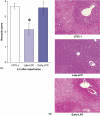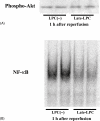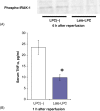Protective effect of lipopolysaccharide preconditioning in hepatic ischaemia reperfusion injury
- PMID: 20887321
- PMCID: PMC2997659
- DOI: 10.1111/j.1477-2574.2010.00211.x
Protective effect of lipopolysaccharide preconditioning in hepatic ischaemia reperfusion injury
Abstract
Background: Preconditioning using lipopolysaccharide (LPS), a toll-like receptor 4 (TLR4) ligand, has been demonstrated to reduce ischaemia/reperfusion injury (IRI) in some organs, but its effect in the liver has not been elucidated. We examined the liver protective mechanism and correlated signalling pathway of LPS preconditioning in mice.
Methods: BALB/c and TLR4 mutant mice underwent 90 min of 70% hepatic ischaemia. Lipopolysaccharide (100 µg/kg) was injected intraperitoneally 20 h or 30 min before ischaemia. Liver damage after reperfusion was examined using serum samples and liver specimens. To analyse the mechanism of preconditioning in detail, phosphorylation of representative signalling mediators to nuclear factor-κB (NF-κB) activation, Akt and interleukin-1 receptor-associated kinase-1 (IRAK-1), and expression of a negative feedback inhibitor, suppressor of cytokine signalling-1 (SOCS-1), were evaluated by Western blotting.
Results: Pretreatment with LPS only 20 h before ischaemia elicited a preconditioning effect; however, preconditioning was absent in TLR4 mutant mice. Lipopolysaccharide significantly decreased serum alanine aminotransferase, tumour necrosis factor-α, hepatocyte necrosis and NF-κB activity after reperfusion. Phosphorylated IRAK-1 was suppressed by LPS, whereas no difference was observed in phosphorylated Akt. Pre-ischaemic LPS provided early induction of SOCS-1.
Discussion: Late-phase LPS preconditioning provided liver protection against IRI through the downregulation of the TLR4 cascade derived from early induction of SOCS-1 during ischaemia/reperfusion.
© 2010 International Hepato-Pancreato-Biliary Association.
Figures






Similar articles
-
Hepatic preconditioning using lipopolysaccharide: association with specific negative regulators of the Toll-like receptor 4 signaling pathway.Transplantation. 2011 May 27;91(10):1082-9. doi: 10.1097/TP.0b013e31821457cb. Transplantation. 2011. PMID: 21403587
-
Lipopolysaccharide preconditioning protects hepatocytes from ischemia/reperfusion injury (IRI) through inhibiting ATF4-CHOP pathway in mice.PLoS One. 2013 Jun 4;8(6):e65568. doi: 10.1371/journal.pone.0065568. Print 2013. PLoS One. 2013. PMID: 23750267 Free PMC article.
-
Aloin Preconditioning Attenuates Hepatic Ischemia/Reperfusion Injury via Inhibiting TLR4/MyD88/NF-κB Signal Pathway In Vivo and In Vitro.Oxid Med Cell Longev. 2019 Nov 20;2019:3765898. doi: 10.1155/2019/3765898. eCollection 2019. Oxid Med Cell Longev. 2019. PMID: 31827674 Free PMC article.
-
LPS Preconditioning Attenuates Apoptosis Mechanism by Inhibiting NF-κB and Caspase-3 Activity: TLR4 Pre-activation in the Signaling Pathway of LPS-Induced Neuroprotection.Mol Neurobiol. 2021 May;58(5):2407-2422. doi: 10.1007/s12035-020-02227-3. Epub 2021 Jan 9. Mol Neurobiol. 2021. PMID: 33421016 Review.
-
Molecular mechanisms of liver ischemia reperfusion injury: insights from transgenic knockout models.World J Gastroenterol. 2013 Mar 21;19(11):1683-98. doi: 10.3748/wjg.v19.i11.1683. World J Gastroenterol. 2013. PMID: 23555157 Free PMC article. Review.
Cited by
-
Administration of dexamethasone protects mice against ischemia/reperfusion induced renal injury by suppressing PI3K/AKT signaling.Int J Clin Exp Pathol. 2013 Oct 15;6(11):2366-75. eCollection 2013. Int J Clin Exp Pathol. 2013. PMID: 24228098 Free PMC article.
-
Down-Regulated Receptor Interacting Protein 140 Is Involved in Lipopolysaccharide-Preconditioning-Induced Inactivation of Kupffer Cells and Attenuation of Hepatic Ischemia Reperfusion Injury.PLoS One. 2016 Oct 10;11(10):e0164217. doi: 10.1371/journal.pone.0164217. eCollection 2016. PLoS One. 2016. PMID: 27723769 Free PMC article.
-
Ischemic postconditioning inhibits apoptosis of renal cells following reperfusion: a novel in vitro model.Int Urol Nephrol. 2015 Jul;47(7):1067-74. doi: 10.1007/s11255-015-0997-x. Epub 2015 May 5. Int Urol Nephrol. 2015. PMID: 25940033
-
Tempol Protects Against Acetaminophen Induced Acute Hepatotoxicity by Inhibiting Oxidative Stress and Apoptosis.Front Physiol. 2019 May 31;10:660. doi: 10.3389/fphys.2019.00660. eCollection 2019. Front Physiol. 2019. PMID: 31214044 Free PMC article.
-
Histone preconditioning protects against obstructive jaundice-induced liver injury in rats.Exp Ther Med. 2014 Jul;8(1):15-20. doi: 10.3892/etm.2014.1697. Epub 2014 Apr 25. Exp Ther Med. 2014. PMID: 24944590 Free PMC article.
References
-
- Takeda K, Akira S. TLR signalling pathways. Semin Immunol. 2004;16:3–9. - PubMed
-
- Kawai T, Akira S. Signalling to NF-kappaB by toll-like receptors. Trends Mol Med. 2007;13:460–469. - PubMed
-
- Biswas SK, Lopez-Collazo E. Endotoxin tolerance: new mechanisms, molecules and clinical significance. Trends Immunol. 2009;30:475–487. - PubMed
-
- Ha T, Hua F, Liu X, Ma J, McMullen JR, Shioi T, et al. Lipopolysaccharide-induced myocardial protection against ischaemia/reperfusion injury is mediated through a PI3K/Akt-dependent mechanism. Cardiovasc Res. 2008;78:546–553. - PubMed
-
- Rosenzweig HL, Lessov NS, Henshall DC, Minami M, Simon RP, Stenzel-Poore MP. Endotoxin preconditioning prevents cellular inflammatory response during ischaemic neuroprotection in mice. Stroke. 2004;35:2576–2581. - PubMed
MeSH terms
Substances
LinkOut - more resources
Full Text Sources

